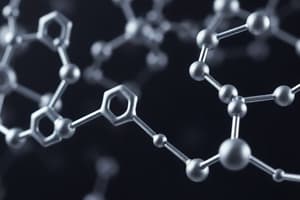Podcast
Questions and Answers
What are the two pentose phosphate pathway intermediates that contribute to amino acid biosynthesis?
What are the two pentose phosphate pathway intermediates that contribute to amino acid biosynthesis?
- α-ketoglutarate and oxaloacetate
- Ribose 5-phosphate and erythrose 4-phosphate (correct)
- 3-phosphoglycerate and 3-phosphoenolpyruvate
- Pyruvate and oxaloacetate
What is the role of aminotransferase enzyme in aspartate biosynthesis?
What is the role of aminotransferase enzyme in aspartate biosynthesis?
- Converts glutamine into aspartate
- Transfers an amino group to a ketoacid (correct)
- Breaks down aspartate into oxaloacetate
- Catalyzes the urea cycle
Which amino acid is classified as non-essential because it can be synthesized by the body?
Which amino acid is classified as non-essential because it can be synthesized by the body?
- Tryptophan
- Phenylalanine
- Aspartate (correct)
- Tyrosine
What is the term for the chemical reaction that transfers an amino group to a ketoacid to form new amino acids?
What is the term for the chemical reaction that transfers an amino group to a ketoacid to form new amino acids?
What is the term for amino acids that include an aromatic ring?
What is the term for amino acids that include an aromatic ring?
What is the byproduct of the urea cycle that is also an amino acid?
What is the byproduct of the urea cycle that is also an amino acid?
What is the common metabolic precursor for the biosynthesis of aspartate?
What is the common metabolic precursor for the biosynthesis of aspartate?
What is the result of the transamination reaction that facilitates the biosynthesis of aspartate?
What is the result of the transamination reaction that facilitates the biosynthesis of aspartate?
What is the benefit of the conjugated double bonds in aromatic amino acids?
What is the benefit of the conjugated double bonds in aromatic amino acids?
Which of the following amino acids is semi-essential in humans?
Which of the following amino acids is semi-essential in humans?
What is the starting material for the synthesis of aromatic amino acids?
What is the starting material for the synthesis of aromatic amino acids?
What is the cost of synthesizing one chorismate molecule?
What is the cost of synthesizing one chorismate molecule?
What is the role of glutamate in the tryptophan biosynthesis pathway?
What is the role of glutamate in the tryptophan biosynthesis pathway?
How many steps are involved in the synthesis of tryptophan from chorismate?
How many steps are involved in the synthesis of tryptophan from chorismate?
What is the consequence of a lack of the enzyme phenylalanine hydroxylase in humans?
What is the consequence of a lack of the enzyme phenylalanine hydroxylase in humans?
What is the role of phosphoenol pyruvate in the synthesis of chorismate?
What is the role of phosphoenol pyruvate in the synthesis of chorismate?
What is the energy source that drives the addition of ribose sugar in the second step of tryptophan biosynthesis?
What is the energy source that drives the addition of ribose sugar in the second step of tryptophan biosynthesis?
Which amino acid serves as the donor of the a-carbon amino group in the last step of the tryptophan biosynthesis pathway?
Which amino acid serves as the donor of the a-carbon amino group in the last step of the tryptophan biosynthesis pathway?
What is the product of the transamination reaction in phenylalanine synthesis?
What is the product of the transamination reaction in phenylalanine synthesis?
What is the characteristic of the reactions involved in the synthesis of phenylalanine and tyrosine?
What is the characteristic of the reactions involved in the synthesis of phenylalanine and tyrosine?
What is the byproduct of the formation of 4-hydroxyphenylpyruvate in tyrosine synthesis?
What is the byproduct of the formation of 4-hydroxyphenylpyruvate in tyrosine synthesis?
What is the starting material for the first five steps of the histidine biosynthesis pathway?
What is the starting material for the first five steps of the histidine biosynthesis pathway?
What is the role of glutamate in the histidine biosynthesis pathway?
What is the role of glutamate in the histidine biosynthesis pathway?
What is the characteristic of the regulatory control of aromatic amino acid synthesis?
What is the characteristic of the regulatory control of aromatic amino acid synthesis?
Flashcards are hidden until you start studying
Study Notes
Aromatic Amino Acids
- Aromatic amino acids are able to absorb light due to their conjugated double bonds.
- Phenylalanine, tryptophan, and histidine are essential amino acids for animals, not synthesized in the human body, and must be derived from the diet.
- Tyrosine is semi-essential; it can be synthesized, but only from phenylalanine.
Biosynthesis of Aromatic Amino Acids
- Begins with the synthesis of chorismate, an important intermediate for many biosynthetic pathways.
- Phosphoenol pyruvate and erythrose 4-phosphate serve as beginning substrates for the pathway.
- The price of one NADPH + H+ and one ATP is exacted for every chorismate formed.
- In the sixth step of the synthesis, another phosphoenol pyruvate molecule is added to the growing molecule.
Tryptophan Synthesis
- Complex and involves 5 steps from chorismate.
- Glutamate donates an amine group in the first step of the pathway and pyruvate is lost from chorismate.
- In the next three steps, a ribose sugar is added, contributing to the 5-membered ring of tryptophan.
Amino Acid Biosynthesis
- Non-Essential amino acids: transamination of α-ketoacids that are available as common intermediates.
- All except tyrosine are derived from one of the following common intermediates: pyruvate, oxaloacetate, α-ketogenic, and 3-phosphoglycerate.
- Essential amino acids: their α-ketoacids are not common intermediates (enzymes needed to form them are lacking).
Biosynthesis of Aspartate
- Synthesized by the body, classified as a non-essential amino acid.
- In humans, aspartate is most frequently synthesized through the transamination of oxaloacetate.
- Transamination is a chemical reaction that transfers an amino group to a ketoacid to form new amino acids.
- The biosynthesis of aspartate is facilitated by an aminotransferase enzyme.
Biosynthesis of Tryptophan
- Energy is contributed to the process in the form of hydrolysis of pyrophosphate.
- This hydrolysis helps drive the addition of the ribose sugar in the second step of the reaction.
- In the last step of the pathway, serine serves as the donor of the α-carbon amino group of tryptophan.
Biosynthesis of Phenylalanine and Tyrosine
- Chorismate is converted to phenylpyruvate in two steps, and phenylalanine is synthesized by a transamination reaction with glutamate.
- The synthesis of tyrosine is very similar to the synthesis of phenylalanine, but the reactions are carried out by different enzymes under different regulatory control.
- No energy is required to run these reactions.
Biosynthesis of Histidine
- The synthesis of histidine is long and complex and its pathway is intertwined with nucleic acid biosynthesis (specifically purine).
- The pathway seems to be universal in all organisms able to synthesize histidine.
- The first five steps of the pathway take ribose from phosphoribosyl pyrophosphate (PRPP) and transform it into imidazole glycerol phosphate.
- Once the imidazole ring is formed, glutamate donates the α-amino group and the newly formed amine is oxidized to histidine in the last step of the pathway.
Studying That Suits You
Use AI to generate personalized quizzes and flashcards to suit your learning preferences.




